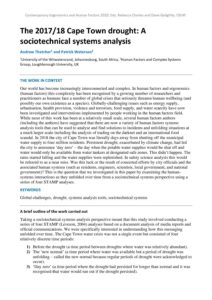| Document | Author Andrew Thatcher and Patrick Waterson |
| Abstract Our world has become increasingly interconnected and complex. In human factors and ergonomics (human factors) this complexity has been recognised by a growing number of researchers and practitioners as humans face a number of global crises that seriously threaten human wellbeing (and possibly our own existence as a species). Globally-challenging issues such as energy supply, urbanisation, health provision, violence and terrorism, food supply, and water scarcity have now been investigated and interventions implemented by people working in the human factors field. While most of this work has been at a relatively small scale, several human factors authors (including the authors) have suggested that there are now a variety of human factors systems analysis tools that can be used to analyse and find solutions to incidents and unfolding situations at a much larger scale including the analysis of trading on the darknet and an international food scandal. In 2018 the city of Cape Town was literally days away from shutting off the municipal water supply to four million residents. Persistent drought, exacerbated by climate change, had led the city to announce ‘day zero’ – the day when the potable water supplies would be shut off and water would only be available from water tankers at designated safe zones. This didn’t happen. The rains started falling and the water supplies were replenished. In safety science analysis this would be referred to as a near miss. Was this luck or the result of concerted efforts by city officials and the associated human systems (such as residents, engineers, scientists, local government, and national government)? This is the question that we investigated in this paper by examining the human-systems interactions as they unfolded over time from a sociotechnical systems perspective using a series of four STAMP analyses. |

